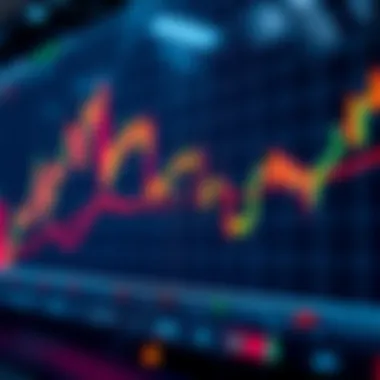The Importance of Moving Averages in Cryptocurrency Trading


Intro
In the ever-evolving world of cryptocurrency trading, having the right tools at your disposal can mean the difference between profit and loss. That’s where the Moving Average (MA) stock indicator comes into play. This invaluable instrument is crucial for traders looking to make sense of market fluctuations, as it aids in smoothing out price data over specific periods. In simpler terms, a Moving Average can help you see the bigger picture, filtering out the noise that often clouds short-term market movements.
Understanding Moving Averages isn’t just for the seasoned trader; even novices can find value in them. Grasping how these indicators work can radically enhance your trading strategies. With this article, we aim to equip investors, tech professionals, and educators alike with a comprehensive exploration of the MA stock indicator and its role in the cryptocurrency landscape. Let’s dive into the nitty-gritty.
Understanding Cryptocurrency Market Trends
To navigate the murky waters of crypto trading, it's essential to grasp market trends. Recognizing these patterns doesn’t only enhance your trading acumen; it can also save you from making hasty decisions that could hurt your investment.
Current Market Analysis
As of late 2023, the cryptocurrency market is filled with myriad trends—from the explosive growth of decentralized finance to the surge of interest in NFTs (non-fungible tokens). Analysts highlight that volatility remains a double-edged sword—offering opportunities while also concealing pitfalls. Currently, indicators like the Moving Average can help clarify trends by leveling out erratic price movements.
For instance, if Bitcoin's price fluctuates wildly within a week, a 50-day Moving Average might show the overall upward or downward trend. This clearer perspective can certainly serve you well when determining entry and exit points.
Historical Performance and Lessons Learned
History often has a funny way of repeating itself, and crypto is no exception. Reflecting on past market behavior can provide invaluable insights. In 2017, Bitcoin skyrocketed to nearly $20,000 before plummeting—an event many claim could’ve been anticipated through an in-depth analysis of Moving Averages.
- Understanding Momentum: Many traders use different types of Moving Averages—like Simple Moving Averages (SMA) or Exponential Moving Averages (EMA)—to gauge momentum. Learning from historical performances, one can spot potential trends and make informed predictions.
- Avoiding Hasty Decisions: History teaches traders to be wary of sudden spikes, a lesson that aligns with the use of Moving Averages to filter out noise.
In short, recognizing patterns through Moving Averages not only makes for better decision-making but also helps to avoid emotional trading.
Key Takeaway: Moving Averages are more than just numbers; they embody a trader's strategy and foresight regarding market conditions.
Practical Guides for Crypto Investors
Navigating the world of cryptocurrency can seem daunting, but with the right strategies, it becomes much more manageable. This section will break down practical guides to help investors, whether they're just starting or looking to refine their skills.
Step-by-Step Trading Strategies


- Identify Your Investment Goals: Before utilizing any indicators, define what you aim to achieve. Whether it’s long-term holding or short-term gains, clear goals will guide your strategy.
- Choose Your Moving Average: Select between SMA and EMA based on your risk tolerance and trading style. EMA reacts more quickly to price changes, while SMA offers more stability.
- Set Up Your Trading Platform: Ensure your trading account—be it on Binance or Coinbase—supports the MA indicators you want to use. Setting this up is critical for on-the-fly analysis.
- Analyze Trends: Use the MA to determine significant support and resistance levels. Watching how prices interact with the Moving Average can shed light on potential entry or exit positions.
- Create a Trading Plan: A solid trading plan outlines your entry, exit, and risk management tactics. This keeps you disciplined amid market turmoil.
Risk Management Techniques
Just because an indicator suggests a particular move doesn’t mean you should leap at the chance. Risk management is key.
- Position Sizing: Determine how much of your capital you’ll risk on each trade. Many experts recommend risking no more than 1-2%.
- Set Stop-Losses: This is crucial in protecting your investment. Set a stop-loss order slightly below your entry point to minimize potential losses if the market swings in the wrong direction.
- Review Regularly: Consistently revisit your strategies and adjust them based on market performance. This not only helps in enhancing strategies but also aids in perpetual learning.
Equipping oneself with the knowledge of how to effectively use the Moving Average can be a game changer in crypto trading. With the right strategies in your trading toolkit, your chances of navigating successfully through the crypto landscape improve markedly.
Foreword to Moving Averages
In the world of cryptocurrency trading, where volatility can turn the market on its head at any moment, understanding the tools available for analysis is key. One such essential tool is the moving average (MA) indicator. Moving averages serve as a fundamental building block for many traders, helping to smooth out price data over a specified period. They filter out the noise of price fluctuations, allowing traders to see the underlying trend more clearly.
The use of moving averages is invaluable in predicting market trends and making informed decisions. They not only assist in identifying the direction of price movements but also play a critical role in establishing key support and resistance levels. What's more, the versatility of MAs means they can be used in conjunction with various other indicators, enhancing their effectiveness and providing a holistic view of the market.
Moving averages can provide foresight into market behavior, but they are not without their complexities and challenges. Traders must grapple with the timing of trades—whether to enter or exit a market position—and this is where understanding the basic concepts and historical context of moving averages becomes crucial. The next sections will elucidate these concepts in more detail and equip readers with the knowledge to navigate the intricate world of crypto trading confidently.
Definition and Basic Concept
A moving average is a statistical calculation that analyzes data points by creating averages of different subsets of the complete dataset. In trading, it is used primarily to smooth out price data to identify trends over time. The most common types of moving averages in crypto trading include the Simple Moving Average (SMA) and Exponential Moving Average (EMA).
The basic idea is simple: by averaging the price over a specific number of periods, the moving average reduces the effect of random or even temporary price shocks. This gives traders a clearer picture of the trend.
For instance, if you were to calculate a 10-day moving average of Bitcoin, you would add up the closing prices of Bitcoin for the past 10 days and then divide by 10. This average shifts as each day passes, hence the term "moving". The key element is that MAs can be customized to various time frames, enabling traders to tailor their strategies based on their trading preferences.
History of Moving Averages in Trading
The concept of moving averages is not new. It traces back to traditional financial markets long before the rise of cryptocurrencies. Early traders recognized the importance of smoothing data to make more educated trading decisions, which led to the development and adoption of moving averages in various forms.
Historically, moving averages have played a part in research dating back to the 1930s when statistical tools began to influence trading practices. As computerized systems emerged in the late 20th century, moving averages became widely used by traders and investors, eventually making their way into algorithmic trading systems.
The rise of day trading and the surge in retail trading in the early 2000s catalyzed greater awareness and usage of moving averages. Today, they are an integral part of many traders' strategies, not just in crypto but across all financial markets. The evolution of technology has further refined their application, enabling traders to utilize more complex algorithms and receive real-time data, enhancing decision-making processes.


By understanding the historical context and the basic principles of moving averages, traders can better appreciate how to effectively leverage these indicators in their trading strategies in the volatile landscape of cryptocurrency.
Types of Moving Averages
When discussing the world of cryptocurrency trading, the Types of Moving Averages play a significant role in how traders interpret price activity. Every type of moving average offers its own set of benefits and nuances. Understanding them not only helps in fine-tuning trading strategies but also aids in grasping broader market trends. Different traders may prefer different types, based on their individual analysis styles or the particular aspects of the market they wish to focus on.
Simple Moving Average (SMA)
The Simple Moving Average (SMA) is perhaps the most straightforward moving average, often serving as a good starting point for beginners. The SMA is calculated by taking the average of a set number of past prices. For example, to compute a 10-day SMA of Bitcoin, one would add the closing prices from the last ten days and divide by 10. The resulting value reflects the average price over that timeframe.
Using a SMA can aid in identifying the overall trend. If the price is above the SMA, it may indicate an uptrend, whereas being below it could suggest a downtrend. Moreover, the SMA is less sensitive to price swings, which can be a blessing or a curse. This particular characteristic results in smoother signals but can lag behind rapid market movements, which might lead to missed opportunities or delayed reactions in crypto trading.
Exponential Moving Average (EMA)
On the other hand, the Exponential Moving Average (EMA) gives more weight to recent prices, making it a bit more responsive to market changes. This sensitivity is particularly advantageous in the volatile world of cryptocurrencies, where rapid price shifts are common. Traders often like using EMA to capture trends quickly.
The calculation involves more steps compared to SMA, as it requires a smoothing factor that adjusts the weight accorded to the most recent data. For instance, to calculate a 10-day EMA, the recent price is given more importance than older prices, thereby providing a fresher perspective of the market.
One significant advantage of using EMA is its capacity to generate faster signals for buy or sell actions. This may lead to swifter engagements for traders during bullish or bearish trends. However, this feature can also trip up newer traders, potentially causing them to react too quickly to price fluctuations.
Weighted Moving Average (WMA)
Lastly, the Weighted Moving Average (WMA) differs from both SMA and EMA by distributing weights in a linear manner. The most recent prices have the highest weights, while older prices have progressively lesser weights. The WMA's formula can appear more complicated than its counterparts, but offers traders the opportunity to create tailored averages based on their market insights.
For example, if a trader believes that the last few days of price action are more indicative of future trends, they can assign higher weights to those recent prices. This customizability makes WMA appealing for detailed analyses in rapidly changing markets.
In summary, knowing the types of moving averages is vital for any trader. Choosing the right moving average depends on various factors: the trader's strategy, their understanding of market conditions, and how they interpret signals. Each type provides unique insights that can bolster trading decisions in the dynamic and often erratic world of cryptocurrencies.
Applications of MA Indicators in Crypto Trading
In the fast-paced world of cryptocurrency trading, where volatility reigns supreme, the Moving Average (MA) indicators serve as a beacon of clarity. They help traders and investors make sense of the myriad of price movements. By smoothing out price data over a specific period, MAs allow individuals to discern underlying trends that might otherwise get lost amidst the noise. Here, we delve into three crucial applications of MA indicators: trend identification, signal generation, and support and resistance levels.
Trend Identification


Identifying the overall trend is paramount when dabbling in crypto markets. This is where moving averages shine the brightest. By plotting a moving average line on a price chart, it becomes easier to see whether the market is in an uptrend, downtrend, or sideways.
For example, if the price consistently hovers above a simple moving average, it indicates bullish sentiments among traders. Conversely, when prices linger below the moving average, it suggests bearish tendencies. This is akin to using a compass in an unfamiliar forest; the MA provides valuable direction amidst the unpredictability of market dynamics.
"The trend is your friend until it isn't."
Traders often look to employ multiple MAs, such as the 50-day and 200-day, to ascertain crossover points. A common strategy is the 'Golden Cross' formation, which occurs when a shorter MA crosses above a longer one, signaling potential upward momentum. On the flip side, the 'Death Cross', where the shorter MA crosses below, may forewarn traders of impending downward shifts.
Signal Generation
In addition to trend identification, moving averages can also generate trading signals. When it comes to initiating trades, accurate timing can spell the difference between profit and loss. MAs can assist in this aspect by indicating potential buy or sell signals based on crossovers.
Let’s say the 10-day EMA crosses above the 30-day EMA. This event may signal traders to consider entering a long position, as it suggests an impending rise in price. Likewise, a crossover in the opposite direction might indicate a time to cash out or go short.
Moreover, some traders employ the concept of 'MA ribbon', using multiple moving averages simultaneously. When several MAs align in a specific manner, traders may view it as confirmation that a significant price movement is on the horizon. This layered approach can create nuanced insights, enhancing overall decision-making.
Support and Resistance Levels
Support and resistance levels are crucial concepts in trading, acting as psychological barriers for price movements. MAs play a pivotal role in defining these levels. Traders often observe how price interacts with moving average lines. If the price approaches a moving average and bounces off, that MA can be considered as a support level. Here, buying pressure may increase, prompting the price to continue its upward trajectory.
Alternatively, if a price breakdown occurs through a moving average, that same line might act as a new resistance level. The whole process acts like a game of tug-of-war; players are constantly trying to push the price beyond these lines.
Utilizing moving averages to determine support and resistance levels can simplify trade dynamics, giving traders clearer entry and exit points. As an illustration, the 200-day moving average often serves as a long-term support or resistance level for many cryptocurrencies, making it a key focal point for serious investors.
Charting Moving Averages
In the volatile world of cryptocurrency trading, charting moving averages becomes a significant tool for traders and investors alike. This concept not only allows market participants to visualize trends but also to make informed decisions based on historical data. Essentially, moving averages smooth out price fluctuations, providing an easier way to interpret market movements and help in identifying overall trends.
One of the primary benefits of charting moving averages is their ability to create a clearer picture of market direction. Instead of getting tangled up in the daily price swings, traders can glance at a moving average line on their charts and gauge whether the market is generally bullish or bearish. This can be particularly useful when trying to avoid the common pitfalls of emotional trading.
Incorporating MA into Price Charts
When it comes to incorporating moving averages into price charts, the process can be relatively straightforward yet immensely impactful. Traders typically overlay moving average lines onto candlestick or bar charts. This visual relationship is what makes moving averages so effective.
- Selection of the Right Moving Average: Traders can choose between different types of moving averages such as the Simple Moving Average (SMA) or the Exponential Moving Average (EMA). The decision often hinges on whether they prefer a simple mean of prices or a more responsive average that gives greater weight to more recent data.
- Time Frame Consideration: Incorporating the right time frame is crucial. For short-term traders, a 10-day or 20-day moving average might be sufficient. On the other hand, long-term investors might find more insight using 50-day or 200-day moving averages.
- Crossovers: One of the significant signals traders look for is the crossover. This occurs when a short-term moving average crosses above or below a long-term moving average, potentially indicating a change in market momentum. To illustrate this: plaintext
- Bullish Crossover: Short-term MA crosses above a long-term MA (buy signal)
- Bearish Crossover: Short-term MA crosses below a long-term MA (sell signal)















